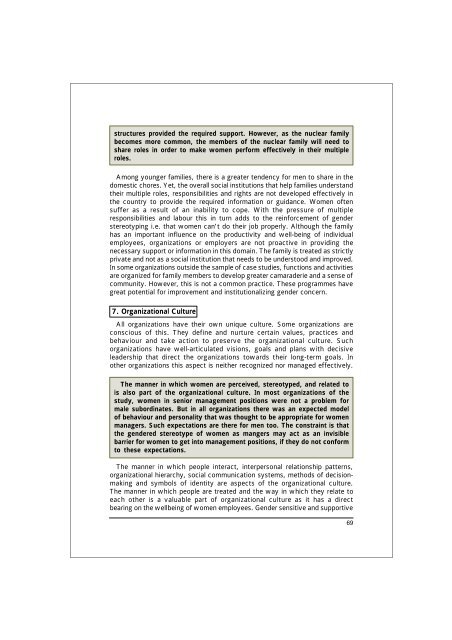Beyond Glass Ceilings and Brick Walls - International Labour ...
Beyond Glass Ceilings and Brick Walls - International Labour ...
Beyond Glass Ceilings and Brick Walls - International Labour ...
You also want an ePaper? Increase the reach of your titles
YUMPU automatically turns print PDFs into web optimized ePapers that Google loves.
structures provided the required support. However, as the nuclear family<br />
becomes more common, the members of the nuclear family will need to<br />
share roles in order to make women perform effectively in their multiple<br />
roles.<br />
Among younger families, there is a greater tendency for men to share in the<br />
domestic chores. Yet, the overall social institutions that help families underst<strong>and</strong><br />
their multiple roles, responsibilities <strong>and</strong> rights are not developed effectively in<br />
the country to provide the required information or guidance. Women often<br />
suffer as a result of an inability to cope. With the pressure of multiple<br />
responsibilities <strong>and</strong> labour this in turn adds to the reinforcement of gender<br />
stereotyping i.e. that women can’t do their job properly. Although the family<br />
has an important influence on the productivity <strong>and</strong> well-being of individual<br />
employees, organizations or employers are not proactive in providing the<br />
necessary support or information in this domain. The family is treated as strictly<br />
private <strong>and</strong> not as a social institution that needs to be understood <strong>and</strong> improved.<br />
In some organizations outside the sample of case studies, functions <strong>and</strong> activities<br />
are organized for family members to develop greater camaraderie <strong>and</strong> a sense of<br />
community. However, this is not a common practice. These programmes have<br />
great potential for improvement <strong>and</strong> institutionalizing gender concern.<br />
7. Organizational Culture<br />
All organizations have their own unique culture. Some organizations are<br />
conscious of this. They define <strong>and</strong> nurture certain values, practices <strong>and</strong><br />
behaviour <strong>and</strong> take action to preserve the organizational culture. Such<br />
organizations have well-articulated visions, goals <strong>and</strong> plans with decisive<br />
leadership that direct the organizations towards their long-term goals. In<br />
other organizations this aspect is neither recognized nor managed effectively.<br />
The manner in which women are perceived, stereotyped, <strong>and</strong> related to<br />
is also part of the organizational culture. In most organizations of the<br />
study, women in senior management positions were not a problem for<br />
male subordinates. But in all organizations there was an expected model<br />
of behaviour <strong>and</strong> personality that was thought to be appropriate for women<br />
managers. Such expectations are there for men too. The constraint is that<br />
the gendered stereotype of women as mangers may act as an invisible<br />
barrier for women to get into management positions, if they do not conform<br />
to these expectations.<br />
The manner in which people interact, interpersonal relationship patterns,<br />
organizational hierarchy, social communication systems, methods of decisionmaking<br />
<strong>and</strong> symbols of identity are aspects of the organizational culture.<br />
The manner in which people are treated <strong>and</strong> the way in which they relate to<br />
each other is a valuable part of organizational culture as it has a direct<br />
bearing on the wellbeing of women employees. Gender sensitive <strong>and</strong> supportive<br />
69
















